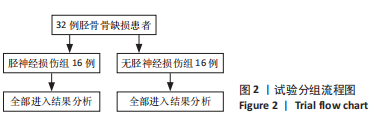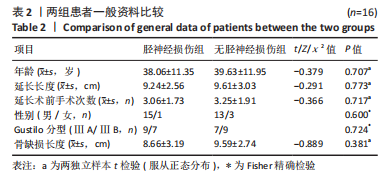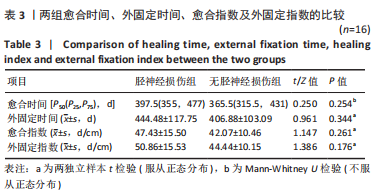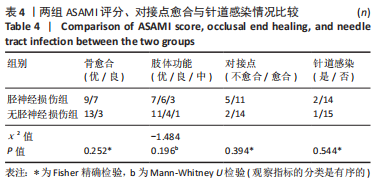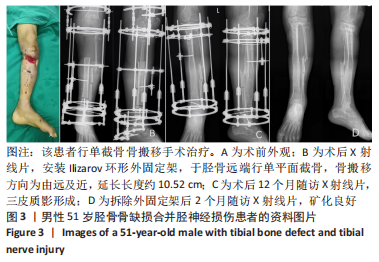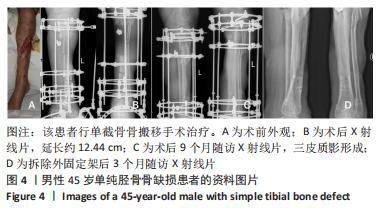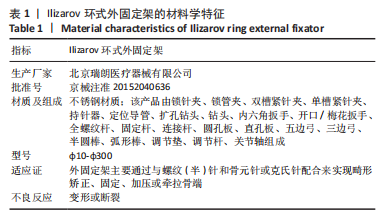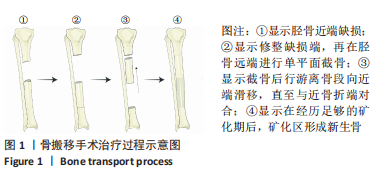中国组织工程研究 ›› 2024, Vol. 28 ›› Issue (12): 1925-1930.doi: 10.12307/2024.031
• 骨科植入物相关临床实践 Clinical practice of orthopedic implant • 上一篇 下一篇
胫神经损伤对胫骨单截骨骨搬移治疗效果的影响
许 奥1,2, 王 斌2, 方 均2, 白崔魏3, 吕梓宸2, 程 康1,2, 郑永鑫1,2, 王红涛1,2
- 1华北理工大学研究生学院,河北省唐山市 063000;2唐山市第二医院骨科,河北省唐山市 063000;3青岛滨海学院附属医院影像科,山东省青岛市 266000
Effect of tibial nerve injury on treatment of tibial single-plane osteotomy and bone transport
Xu Ao1, 2, Wang Bin2, Fang Jun2, Bai Cuiwei3, Lyu Zichen2, Cheng Kang1, 2, Zheng Yongxin1, 2, Wang Hongtao1, 2
- 1Graduate School of North China University of Science and Technology, Tangshan 063000, Hebei Province, China; 2Department of Orthopedics, Tangshan Second Hospital, Tangshan 063000, Hebei Province, China; 3Department of Imaging, Affiliated Hospital of Qingdao Binhai University, Qingdao 266000, Shandong Province, China
摘要:
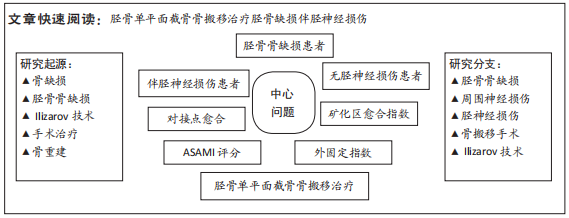
文题释义:
骨搬移技术:是指利用牵张成骨原理将游离骨段搬移至骨缺损处,搬移这段距离长出新生的骨组织,最终实现骨延长。该技术的优点为手术简单、风险小,可以同时实现大段骨组织及周围软组织、神经、血管的再生。神经轴索断裂:又称鞘内中断,主要发生轴索和髓鞘断离而神经膜完整,可表现为运动和感觉功能丧失和肌萎缩,肌电图变化根据受压程度而异。外观神经连续存在,受压部位神经轴索断裂,神经的主要功能存在。
背景:周围神经在骨代谢中扮演着重要角色,但临床上神经损伤对骨搬移技术的影响有待进一步研究。
目的:探讨胫神经损伤对胫骨单截骨骨搬移手术治疗效果的影响。方法:选择2011年5月至2022年6月唐山市第二医院收治的胫骨骨缺损患者32例,根据是否合并胫神经损伤分为胫神经损伤组(n=16)与无胫神经损伤组(n=16),两组均接受单截骨骨搬移手术治疗。治疗后进行随访,观察两组患者矿化区愈合指数、外固定指数、对接点愈合及针道感染等情况;拆除外固定后,采用Ilizarov方法研究与应用协会(ASAMI)评分标准评价骨愈合和功能评价。
结果与结论:①32例患者治疗后均获得随访,平均随访(25.28±4.79)个月,两组骨性愈合时间、外固定时间、愈合指数与外固定指数比较差异均无显著性意义(P > 0.05);胫神经损伤组2例、无胫神经损伤组1例出现针道感染,均为PALEYⅠ度,组间比较差异无显著意义(P > 0.05);胫神经损伤组对接点不愈合率为31%,无胫神经损伤组为13%,组间比较差异无显著性意义(P > 0.05);两组ASAMI骨愈合评分的优良率均为100%,肢体评分优良率胫神经损伤组为81%、无胫神经损伤组为94%,组间比较差异均无显著性意义(P > 0.05);②结果表明,胫神经损伤对胫骨单截骨骨搬移手术治疗的矿化速度、外固定时间、对接点愈合、针道感染、矿化区成骨质量等无明显影响。
https://orcid.org/0000-0001-8406-3719 (许奥)
中国组织工程研究杂志出版内容重点:人工关节;骨植入物;脊柱;骨折;内固定;数字化骨科;组织工程
中图分类号:
